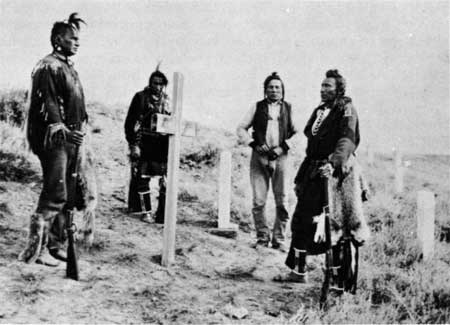|
LITTLE BIGHORN BATTLEFIELD National Monument |
 |

Custer's Crow Indian scouts visit Custer
Battlefield. From left to right are White-Man-Runs-Him, Hairy Mocassin,
Curley, and Goes Ahead.
(Photograph by Wanamaker about
1916.)
Custer's Troops Take to the Trail
General Custer had started up the Rosebud Creek with about 600 soldiers, 44 Indian Scouts, and 20 or more packers, guides, and civilians. They moved cautiously along the creek, crossing it several times as they sought the most advantageous marching and camping ground. The afternoon of the third day, June 24, the scouts reported that the Indian trail they were following turned abruptly to the right and went west ward toward the Little Bighorn River Valley. They were then only about 8 miles from where the Indians had defeated Crook's forces on June 17, but having received no communication from General Crook, they had no knowledge of the battle. After darkness set in and the men and horses had rested, Custer broke camp and continued to follow the trail. During the night the cavalrymen moved several miles nearer the high divide between the Little Bighorn and Rosebud Valleys. Then they halted to await daylight so that a more careful reconnaissance of the surrounding country might be made.
At daybreak, from a high point on the divide, the scouts observed smoke in the Little Bighorn Valley, implying that the Indians were encamped there. This information was carried to Custer, but by the time he reached the point a haze, caused by the brilliance of the sun, obscured the view. Evidently, Custer was not entirely convinced as to the location of the Indians. On returning to camp, he was informed that the Indians had discovered their presence. He then called a conference of officers and to them he stated that his plan had been to rest a day in the hills and to make the attack early on the morning of the 26th as was previously outlined by General Terry. Their discovery by the Indians, however, altered the plan, and it now seemed urgent to attack at once. A delay until the next day might result in the escape of the Indians.

|
|
Last Modified: Sat, Sep 28 2002 10:00:00 pm PDT |


